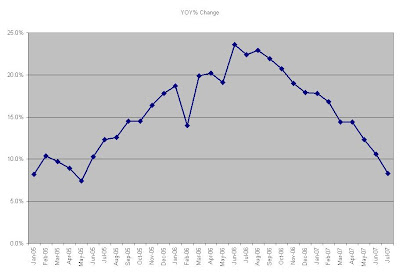By Mark Gilbert - Aug. 16 (Bloomberg) --
Dear investor, we'd like to take this opportunity to update you on the recent performance of our hedge fund, Short-Term Capital Mismanagement LLP.
As you know, market selection for the entire fund is guided by a proprietary investing tool we like to call ``a dartboard.'' Once the asset classes are decided, individual security selections are generated by digitizing our unique hexagonal cuboid models.
Unfortunately, it transpires that our hexagonal cuboids are not as unique as we thought. Hundreds of other hedge funds possess identical dice. The technical term for this is a ``crowded trade.'' You may also see it referred to as ``climbing on a bandwagon already headed for the wall.''
As our alpha generation collapses, our beta has turned negative, our delta hedging has gone toxic and, trust me, you do not want to hear about our gamma. We can't even find our epsilons in the dark with both hands.
You will appreciate that accurate pricing is essential for evaluating our investment strategies. This has proven to be extremely challenging in recent days. Previously, we have relied on Bob, the sales guy at Hokey-Cokey Bank. Bob assured us the securities were still worth 100 percent of face value, so everything was cool. Bob sold the collateralized debt obligations to us in the first place, so he knows what he's talking about.
Bob, however, appears to have had a nervous breakdown, judging by the maniacal laughter that greeted our requests for price verification this week. Our efforts to implement an in- house CDO valuation framework, using a technique the ancients knew as ``making things up,'' proved unsatisfactory.
Where's the Bid?
Currently, all of the portfolios we manage are undergoing a rigorous screening known as ``crossing our fingers and praying that we don't have to try and find a bid in the market.'' This is supplemented by a cross-market statistical analysis originally developed by the U.S. military called ``don't ask, don't tell.'' This ``unmarking-to-unmarket'' procedure has been the benchmark for the hedge-fund industry for the past, ooh, 72 hours.
We have, of course, been in touch with the rating companies to update our default-probability scenarios, particularly on the AAA rated investments we own. They recommended a forecasting method using stochastics to regress the drift-to-downgrade timescales for the past 100 years and throw them forward for the next five minutes. The technical term for this is ``induction,'' though those of you of a less quantitative bent may know it as ``guessing.''
AAA or Toast?
We are pleased to report that, contrary to what current market prices might suggest, all of our top-rated securities remain absolutely AAA. Provided, that is, the future performance of the underlying collateral is identical to its history. Otherwise, the rating companies say our investments are likely to be reclassified as ``toast.''
We have also been checking our back-up credit lines with our friends in the investment-banking world. As soon as they return our calls, we'll be able to update you on our emergency liquidity position. We are sure they are fine.
Some of you have written to us asking for your money back, citing clauses in the fund documentation called redemption rights. Frankly, we never expected you to actually read that prospectus, which came prepackaged when we bought the Microsoft Hedge-Fund Guy software. We certainly have no idea what all those long words mean.
We have filed your letters in a special drawer in the filing cabinet marked ``trash'' for now. Do you have any idea how much trouble you all would be in if we actually sold this stuff in the market today? At these crazy prices? Fuhgeddaboudit. You'll thank us later.
Not a Rescue
Speaking of crazy prices, we know you'll be thrilled to learn that we've invited a bunch of our rich pals into the fund to participate in this once-in-a-lifetime opportunity. But this is not a rescue. Do not even think the word rescue. This is an opportunity. Not a rescue. An opportunity.
In fact, we think this is such a fantastic opportunity, we've agreed to forgo our usual management fee, and we'll only take half our usual slice of the profits. Provided there are any profits to slice. You, of course, are absolutely invited to participate in this offer by sending us yet more of your money on exactly the same revised terms as our rich pals.
Finally, a word for all of you who have been kind enough to inquire about my personal financial situation. I am relieved to report that my directors and officers insurance is fully paid up. Furthermore, my Bentley Continental was paid out of the 2 percent fee we levied when you wrote your first check to us, so I will still be able to trundle into the parking lot each morning in an open-necked shirt to ignore your telephone calls and e-mails.
Yours,
Hedge-Fund Guy.























